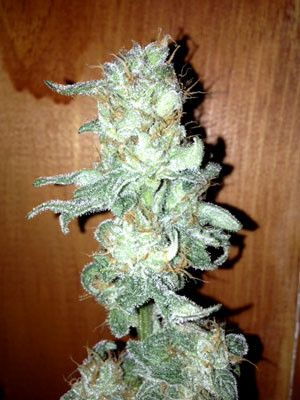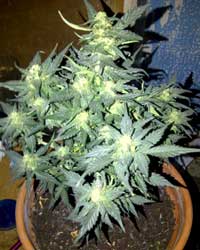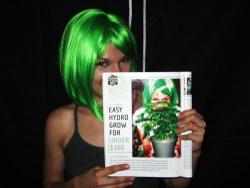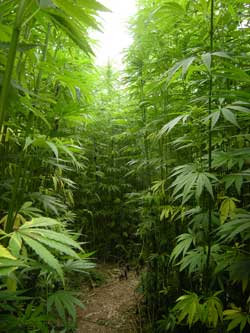Issue #49 - Sunday, March 24, 2013 Dear Fellow Grower, In today's issue...
- You'll learn the difference between autoflowering & photoperiod strains.
- Discover 3 proven auto-flowering strains available online
- See the amazing results one grower has produced with autoflowering Northern Lights.
Happy Growing!
Nebula Haze & Sirius Fourside (founders of GrowWeedEasy.com)
"Earth laughs in flowers." ― Ralph Waldo Emerson
Quick Key to Cannabis Light Schedules |
Quick Key to Light Schedules For Photoperiod (Non-Autoflowering) Strains Vegetative - Photoperiod cannabis plants kept on these light schedules will display only vegetative growth
18/6 - 18 Hours Light / 6 Hours Darkness each Day
24/0 - 24 Hours Light / 0 Hours Darkness each Day Flowering
- Indoor cannabis plants on this light schedule will grow flowers (buds). This is the second life stage, and cannabis plants will stay in this life stage until harvest. 12/12 - 12 Hours Light / 12 Hours Darkness each Day * Most indoor growers use a
timer to turn their lights on and off automatically.
(Which seed banks are safe to order from online?)
|
Photoperiod vs Autoflowering Strains by EasilyUsed |
When looking at seed options online, there are "photoperiod" and "auto-flowering" strains of cannabis available. What do these terms mean? Today, EasilyUsed breaks it down for you... Republished with permission, click for original article
|
Photoperiod Cannabis Strains: Will vegetate essentially indefinitely on anything between an 18/6 and 24/0 light cycle -
Can be cloned, one seed = unlimited plants Will flower once put into a 12/12 light cycle Usually will produce a usable yield in a longer amount of time Can produce a larger plant and therefore higher yield Will produce a more potent bud Can take more abuse due to unlimited vegetation period Responds well to topping and super cropping in the vegetative cycle
Autoflowering Cannabis Strains:
Will vegetate for a limited amount of time before automatically going into flowering mode (each strain's vegetative time will be different) Cannot be cloned (in the traditional sense), one seed = one plant Will flower automatically, regardless of light cycle Usually will produce usable yield sooner
Will produce a smaller plant and therefore limited yield Will produce less potent buds Can't take much abuse due to limited growth time May not respond well to topping and super-cropping
Both Photoperiod and Autoflowering:
In its natural state, cannabis is an annual plant. This means that these plants grow from new seeds every year, and die at the end of the flowering process, ideally mating, creating and releasing seeds that will grow as the next generation
Can be stressed and hermie (grow both male and female parts) as a result of incorrect light cycle changes Seeds can generate male or female plants, unless seeds are feminized Need the same amount of nutrient care Can potentially be grown to produce the same size plants with similar yields -
Respond well to LST and SCROG

Photoperiod Cannabis Strains
Photoperiod cannabis is the 'industry' standard; it is the natural state of THC-potent cannabis strains. Cannabis sativa and cannabis indica will vegetate almost indefinitely on anything between an 18/6 and 24/0 light schedule, and will only enter full flowering mode when its lighting schedule is limited to 12/12.
When growing outdoors, photoperiod strains of cannabis are planted in the spring, naturally entering flowering mode at the end of the summer when the days become shorter. These cannabis plants will universally be ready to harvest in the fall.
The exact time to harvest for photoperiod plants depends on the specific strain and your location (the timing of sunlight availability varies based on your latitude). Photoperiod strains of cannabis will not naturally grow outdoors during any other time of year besides Spring and Summer (at least, not without supplemental lighting and enforced darkness).
Photoperiod cannabis may be easier to grow indoors for new growers because it can be abused in the vegetative state and have time to recover because it can be vegetated until the grower decides to change the light cycle to flowering. The flowering process is generally thought to be the most delicate time for the plant; so the utmost care should be given to a plant in its flowering cycle.
Note by Nebula: In some instances, photoperiod strains of cannabis may be easier to grow indoors if you are a new grower because you can give yourself as much time as you need in the vegetative stage. During this stage, cannabis plants are hardy and can bounce back from problems. Even if you make a lot of mistakes, you can still get big yields because you are in control of when the flowering stage begins, unlike with autoflowering strains. Once the flowering cycle is initiated, your plants are more "set" as far as their overall health and structure. Once a cannabis plant starts budding, there is basically a countdown until buds are ready to harvest (this amount of time is mostly based on the strain). Though the plant may have an initial last "stretch" of vegetative growth when the light cycle is first changed over, as the plant approaches harvest towards the end of the flowering stage, almost all growth halts except the development of bigger buds.
This bears repeating: The flowering process is generally thought to be the most delicate time for the plant; so the utmost care should be given to a plant in its flowering cycle. Photoperiod cannabis can be cloned indefinitely. This means that a single photoperiod plant can basically live forever and be used to create an infinite amount of plants.
Cuts taken from photoperiod cannabis plants can be rooted to create clones of the original plant, and these new clones can be vegetated into large plants before being put into (or back into) the flowering stage. Autoflowering Cannabis Strains
Autoflowering cannabis is a human-created crossbreed of cannabis ruderalis and cannabis sativa and/or cannabis indica. Cannabis ruderalis is a strain of cannabis with a unique property. This strain naturally enters the flowering cycle based on time since germination, regardless of light cycles or photoperiods.
This is in contrast to photoperiod cannabis, which will generally only enter flowering when the light cycle has been changed to 12/12.

The automatic flowering nature of ruderalis creates a smaller plant, as its vegetative cycle is naturally limited, whereas a photoperiod strain can be vegetated into a much larger plant before switching to a flowering light cycle.
Note by Nebula: The auto-flowering plant pictured to the left is 2 months from seed and has been well-cared for. This plant naturally stayed short and bushy and displays the classical growth pattern of most auto-flowering strains. This plant still has a few weeks before time-to-harvest, and buds will continue to fatten up. Cannabis ruderalis is also a non-THC potent strain, so when it is cross bred with high-THC-producing sativa or indica, it retains some of the ruderalis properties, and some of the sativa or indica properties, leading to a lesser THC content than a strictly non-ruderalis strain.
Between these two traits, autoflowering strains will theoretically produce not only less bud, but also less potent buds. Photoperiod strains that are flowered immediately or grown in limited root-space can produce similarly small-sized, quickly flowering plants, but they ought to have a larger THC concentration than their autoflowering counterparts. THC content is still a matter of debate between autoflowering cannabis proponents and detractors.
Autoflowering strains seem more user-friendly for new growers because of the absence of light-cycle decisions. This is a sort of fallacy, as new growers tend also to abuse plants more than seasoned growers. Autoflowering strains will enter flowering (the most delicate stage of growth) regardless of their health
.

Note by Nebula: The auto-flowering White Widow plant pictured to the right is sick and stunted. Because of the auto-flowering nature of this strain, the grower was unable to nurture the plant back to health before the flowering stage began. In this picture, the plant is 2.5 months old (started from seed like all autoflowering plants), and the buds are almost ready for harvest even though they're still so small and airy, they're practically non-exitant. As a result, the total yields from this plant will be very low (just a few grams). This can be discouraging as the grower must start over with a new seed in order to try for a bigger harvest.
Photoperiod growers have the choice of entering the flowering period whenever they choose, allowing them to choose this when their plants are healthiest, as well as allowing for more vegetative time for their plants to recover from earlier mistakes. Autoflowering strains will enter the flowering stage in stressed or unhealthy states automatically, which can limit bud yields.
Autoflowering cannabis cannot be cloned in the traditional sense. That is, autoflowering cannabis will always retain its 'internal flowering timer.'
If you make a cut of autoflowering cannabis, it can potentially root and create an independent plant, however, this clone will still have the internal clock set to the same automatic flowering clock as its mother. The clone and mother will still flower at the same amount of time after the original seed they both came from was germinated. Given that autoflowering strains have a very short vegetation cycle, it is debatable whether or not you'd gain a larger yield from making a lot of small flowered clones from one auto or if you let the auto vegetate and flower into one large plant.
Along the same lines, the limited vegetative cycle does not allow for very much drastic growth techniques like topping and super cropping, as the plant doesn't have a lot of time to recover from these before it flowers. Autoflowering cannabis can be grown outdoors any time of year (assuming it has a reasonable, stable environment in terms of temperature, etc), since it will flower with any light cycle.
Autoflowering cannabis can be grown outdoors in conjunction with photoperiod cannabis to harvest twice in a summer season; once quickly from the autoflowering, and later a second harvest from the photoperiod cannabis. Autoflowering cannabis is thought to be best grown in anything between a 18/6 and 20/4 light cycle, as it gets a lot of light, but also has time to recover in darkness. It can, however, be grown in 12/12 permanently or 24/0 permanently.


Who Runs This Newsletter?
|
Nebula Haze:Marijuana has literally saved my life, and I'm dedicated to showing you how easy it can be to grow.
I have made it my mission to build growing resources to help both new and advanced growers get bigger, better yields with less time and money.
|

|
|
Follow:


|
Sirius Fourside:Sirius Fourside is a hobbyist grower who has gained the bulk of his experience growing in water as a medium(deep water culture, bubbleponics). "Growing cannabis is a relaxing hobby in and of itself, but it also saves you money and keeps you from having to deal with shady characters. Cannabis is much easier to grow than people give it credit for, and growing in water doesn't increase the difficulty much, if any. But whether you want to grow in water, perlite, or a different medium, we'll show you how easy it can be!"
Which Auto Strains Should I Get? |
Proven Auto-Flowering Strains A sturdy strain is easy to grow and a good choice for first-time indoor growers. Performs very well indoors, naturally stays short/bushy, low odor, and potent buds just like the famous Northern Lights strain. - Best Indoors - Good for Beginners
- Low Odor - Potent Buds Like Regular Northern Lights Great option for outdoor growers with very short summers as she's ready to harvest just 2-3 months after sprouting from seed. One of the original auto-flowering strains, with decent yields and a good buzz. - Best Outdoors (Short Summers) - Ready to Harvest in 2-3 Months - Pleasant Buzz -
Neutral odor while growing that is reminiscent of hay or flowers, and tropical fruity smell/taste after being harvested and cured. Given the right conditions (happy plants, cooler temps at night as you approach harvest), this strain often shows hints of blue or purple in the buds/flowers. Plants tend to grow a bit bigger than other autos and this strain usually needs a full 3 months of growth before being ready to harvest. - Indoors or Outdoors - Neutral odor while growing - Fruity / tropical smell after buds are cured - Buds often blue or purple
- 3 months before ready to harvest
Click Here to See More Autoflowering Strains
|
This plant is much larger than most auto-flowering plants, but shows what can be possible when auto-flowering plants are well taken care of throughout their life. Do you have beautiful trophy pics you'd love to share?
Submit your marijuana pictures here: http://growweedeasy.com/submit-trophy-pics
Anyone who sends us pictures is kept completely anonymous!
We thoroughly inspect pictures to ensure your privacy remains safe.
Remember, sharing is caring!
Forward this email to a friend in need!
Where Can I Buy Marijuana Seeds Safely? |

|
How can I safely get marijuana seeds?
Now you have 2 real options...
- Use random bagseed that you find in your buds
- Buy seeds of specific marijuana strains online
Now if you want to pick the perfect strain for your needs, that's going to be hard with bagseed...
And if you're growing outdoors, it's even more important you find a strain that exactly suits your climate.
So...
Learn how growers are buying marijuana seeds online
|
|
Copyright (c) 2013 GrowWeedEasy.com
NOTE: If URLs do not appear as live links in your e-mail program, please cut and paste the full URL into the location or address field of your browser.
Disclaimer: Grow Weed Easy only recommends products that we've either personally checked out ourselves, or that come from people we know and trust. For doing so, we may receive a commission. Nothing in this e-mail should be considered personalized Financial, Legal, or any other kind of Advice. The contributors to this magazine grow legally under their local laws. If you cannot legally grow where you live, we DO NOT recommend that you start growing marijuana, as you can be arrested, put in prison, or worse!
Any decision to grow marijuana should only be made after consulting with an experienced lawyer or other legal adviser. Although our employees may answer your general customer service questions, they are not licensed under securities laws to address your particular investment or legal situation. No communication by our employees to you should be deemed as personalized Financial or Legal Advice. Any investments and steps recommended in this letter should be made only after consulting with your lawyer or other legal or investment adviser.
Nothing in this e-mail should be considered personalized Health Care Advice. Although our employees may answer your general customer service questions, they are not licensed health care professionals. No communication by our employees to you should be deemed as personalized Health Care Advice. Any Health Care recommended in this letter should be made only after consulting with your Doctor and licensed Health Care Advisor.
Follow:


|
Didn't Sign Up For This Newsletter?
Our records indicate that requested to be added to the GrowWeedEasy.com weekly newsletter at .
Date:
To unsubscribe: |
|